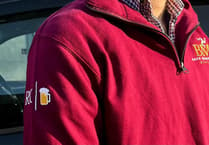After previously having the pleasure of chatting to different members of Hospice Isle of Man’s clinical teams about the countless services they offer, I’m back at the charity, this time speaking with some members of the Board of Governors. Every person radiated the very nature of the charity itself – warm, welcoming, and incredibly caring.
‘I think for me; it’s about people understanding the decisions Hospice Isle of Man makes.’
That is Catherine Black, a Hospice governor - on the Board as a clinical representative - and Deputy Director of Education for Manx Care. She’s telling me about why she thinks it’s important for the Manx public to know more about the Board and how Hospice is governed.
‘Whether it’s about clinical services, different ways of fundraising, or about how we are using the money raised, I think the public have a right to that transparency.’
‘From my side of things’ Hospice Isle of Man CEO John Knight adds, ‘I have worked for seven charities during my 39 years in the voluntary sector and I believe Hospice Isle of Man can serve as an invaluable source of advice and support for other charities, particularly those in their early stages. It’s not about bragging about Hospice; it’s about showcasing our exemplary standards of governance and scrutiny which provides a powerful model for best practice within the sector.’
Hospice’s Board comprises a wide range of outstanding volunteer Governors, each of whom has experience and expertise in a crucial discipline that makes the whole greater than the sum of its parts. From commercial acumen and business development to finance experts, fundraisers, marketing, legal representation, clinicians, and HR, the list is extensive and essential to making the best decisions for patients and their loved ones.
‘It’s definitely the highest calibre Board I’ve ever worked with.’ Chris Hall says. He’s Chairman of the Board of Governors and was recently named IOD Non-Executive of the year.
‘And it’s definitely more challenging than running a business.’ Chris tells me.
He works with a range of different businesses on the island so sees first-hand the added challenges that comes with working with charities.
‘It’s much more complex. We must balance financial sustainability with the charity’s mission to serve the community. Unlike business where the board is focused on profit, we must remain patient-centric and prioritise stakeholder engagement, and long-term impact, whilst navigating additional medical regulations, inspections and compliance. Sometimes with a business it’s easier to say, “Okay, that isn’t profitable, so we’ll drop it, or our costs have risen so we will have to review pricing, but for a charity whose goal is to provide excellence without payment, these options aren’t open to us. Our biggest challenge is to raise enough money to deliver clinical excellence and meet rising demand.’
Catherine adds, her tone sincere. ‘Any decision looking at making the best use of every penny can get very complicated. This is where I think the Board excels, in its ability to remove groupthink. Whilst we are all specialists in our respective fields, we recognise there are limitations to our knowledge in other areas of the organisation. We challenge and are challenged – we expect to have to be able to explain our reports and recommendations, so every member has a full understanding of what is being discussed.
‘I think this borders into professional interrogation as well’ John adds. ‘It means we have to be able to justify what we’re spending money on and why we’re making the choices we’re making.’
‘What do you think are the critical components of Board of Excellence?’ I ask the table.
‘We could spend an hour on this’ Chris says with a light laugh. ‘But firstly, it’s having a shared vision, goals, and objectives and below that, it hinges on clearly defined roles and responsibilities. If you have good governance at the top, then everything else can flow. We all have an absolute passion to make sure the Isle of Man Hospice is the best in the UK.’
It’s an easy thing to say, to want to be the best in a certain area, but how does Hospice back that up practically and deliver that excellence?
Chris explains that there are 220 adult hospices in the UK and 35 children’s hospices. There is therefore a wealth of benchmarking data to compare everything they are doing to make sure Hospice Isle of Man are at the top of the league table. But it’s not just about comparing Hospice Isle of Man to others, the Board also puts a big emphasis on self-reflection in order to grow.
Chris outlines how they achieve this.
‘We review our own performance, because you should always be challenging and striving for continual improvement. We recently completed an external, independent Board effectiveness review. It’s given us a very good report, which said the governance is very good, but you’re never perfect. So, we’ve got some very specific things we can do to get even better.’
There is also an annual internal UK wide survey undertaken by the staff and volunteers that involves Board effectiveness called the Birdsong Review. Again, this shows a desire to take feedback to keep getting better.
For John, good internal communication is vital, and this starts at the top, creating an overstory that shows Governors caring about and gaining knowledge on the actual inner workings of the charity.
‘The Board members are all committed to coming into the building, meeting staff and gaining an understanding of how we operate’ John tells me. ‘They know the charity. And if somebody stopped them in the High Street and said, “Tell me this about this aspect of Hospice” there is a very good chance they could answer.
That knowledge and attention to detail is acquired in great part from the Board’s multiple subcommittees, which creates a whole ethos of open communication and shared information. It’s another key component in Hospice being able to put its money where its mouth is in saying they want to be the best.
‘By the time I’m going to the Board with an idea or query, it’s been through the relevant subcommittee and is backed by not only Hospice staff but also say a pharmacist, a GP, a paramedic, a hospital consultant, and so on, so we’re covering all areas’, Catherine tells me. ‘Therefore, it’s not just me asking the Board a question, it’s all the people working clinically within Hospice as well as external healthcare professionals that would be impacted by their decisions.’
‘It’s also about planning for the future’ Chris says. ‘Many Boards can get bogged down talking about what’s happened, but we have our eye on the future. My rule is that two-thirds of our Board meeting is spent looking forward, and one-third on reporting. The key thing we’re obsessed with is sustainability and making sure that the charity is here in five, ten, fifteen-years-time. And I suppose the other component of Board excellence is we have a healthy turnover of membership’ Chris says. ‘Because one of the challenges of achieving excellence is if a group works together too long, it can get stale. And I think we’ve got that just right at Hospice, we have a balance of people who’ve got a lot of experience and great institutional memory but every year we have two or three new Governors joining the Board, which gives us that fresh energy. Because we have several excellent people supporting each of the subcommittees, we have a natural flow through of people to the Board who understand the complexities of the organisation.’
Everything Hospice strives to achieve would be made ten times harder if there wasn’t a strong culture in place at the organisation. The charity places a lot of importance on creating a culture that encourages open dialogue, thorough information gathering, and, in the words of Chris, ‘no surprises.’
‘There is a really tricky balance between operational management and governance’ Chris explains. ‘It’s a big issue for any Board, isn’t it? Good communication between the CEO and Board is paramount. Being accessible when required but at the same time empowering the team to manage the operational issues. John doesn’t need to tell me every single thing, if he did, I’d spend half my life here, but if there is something significant happening then that will be flagged. No surprises!’
With his eye on how Hospice can support other charities with best practice John adds ‘Thinking of people who are running, say, a smaller charity, but looking to grow, I would say a focus on risk management and understanding the importance of a very thorough risk register is key. Learning, or being informed around what is good risk management in a charitable organisation.’ Chris qualifies this, ‘We take commercial best practice on managing risk and bring it into the charity world.’
We’ve covered Hospice’s aspirations and the work going on behind the scenes to achieve those goals but what are the hurdles standing in the way?
‘I would say the bits we control; the delivery is exceptional. The bits which are challenging are the bits we can’t control’ Chris tells me. And those challenges predominantly lie with raising sufficient funds to meet the increasing demand. Like so many, Hospice Isle of Man could offer so much more if it had the resources to do so.
‘We can only spend what we have’ Catherine adds. ‘That’s the real difficulty of that balance for the Board. We could have lots of ideas for clinical services, but we’re not an organisation that will put itself in the red to do that. We could do the all the extra things we would like to do for a year and then have no hospice in three years’ time. So, how do we navigate that?
‘We do have ambitions to deliver more for the Isle of Man, but we can only do it when we have the money in place.’ John says, echoing Catherine.
The big question is what is the solution to that giant financial hurdle standing in the way of Hospice being able to offer Manx residents so much more?
John is first to give his thoughts.
‘One of my challenges is balancing this message that we must be optimistic and ambitious, because that is the only picture we can create for the staff, volunteers and the community. But equally, we don’t want to be overly stating that everything’s fine if it’s not. I feel we’re constantly trying to find that right message, which is, we’re not the big, rich charity on the hill. You know, we do have an ambition, but paying for it is a real challenge.’
A solution John wants to bring to the table is to diversify the way Hospice generates money.
‘Acting more commercially for me is undeniably a part of the future. But of course, that needs the blessing of the people who would carry the can if it all went wrong.’
‘The challenges in the NHS and the UK Hospice sector are extremely well documented with rising demand, rising costs and Hospice Isle of Man is facing exactly the same challenges’ Chris tells me. ‘One thing we’ve done in the past is invest in digital technology to ensure we operate efficiently. So, we are operating more efficiently. Now, what we have to do is identify innovative, new sources of income.’
‘But there isn’t a silver bullet’ John adds. ‘I don’t think there’s one new income stream that will solve the challenges. It’s multiple.’
‘We’ll find solutions. We have to’ Chris says. ‘Because we are determined to provide the best possible palliative and end of life care for the island.’
The passion and sincerity with which each Board member spoke about Hospice Isle of Man made it a pleasure speaking with Catherine, Chris, and John. Here were three members of a Board who didn’t see themselves as above the incredible 500 plus staff and volunteers working at the charity but as one of them, part of the team, wanting to help make Hospice Isle of Man the best it can be for our community.




